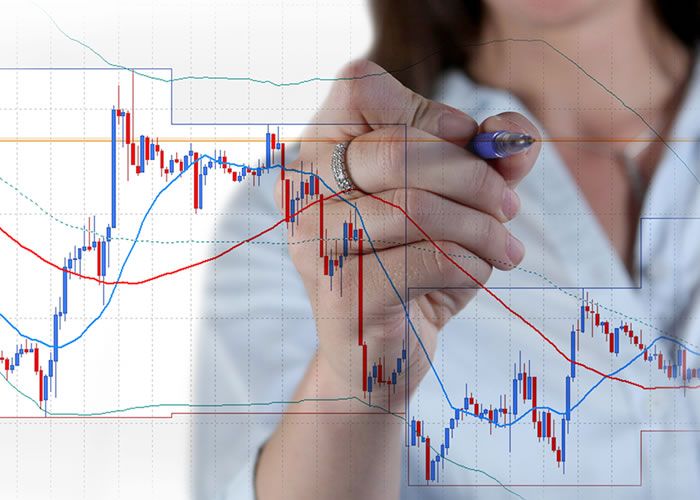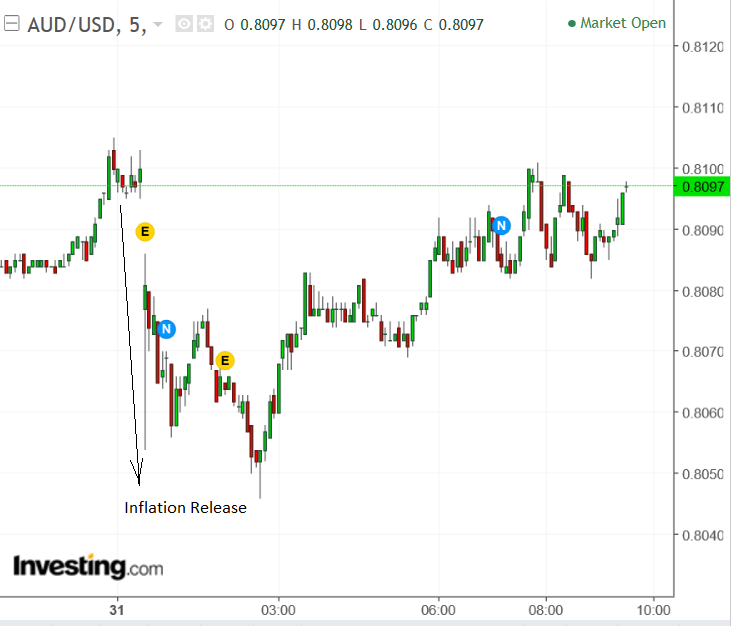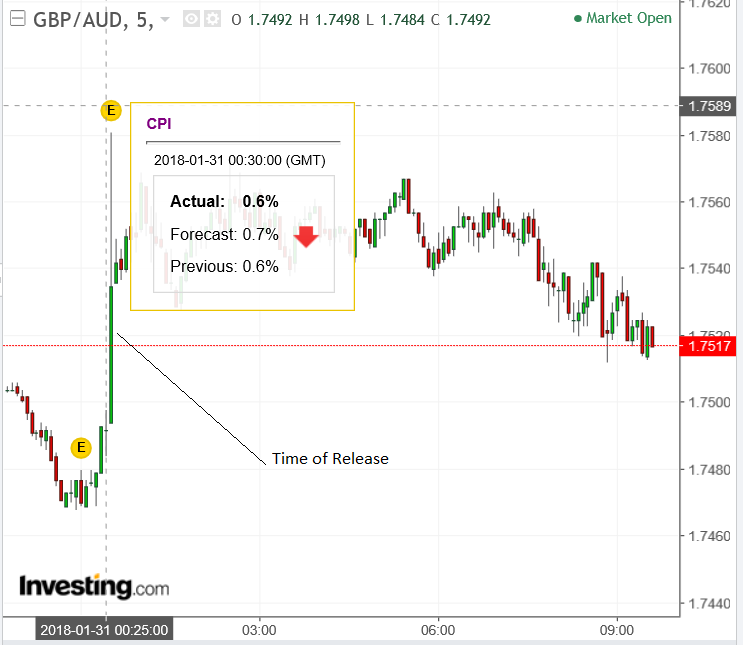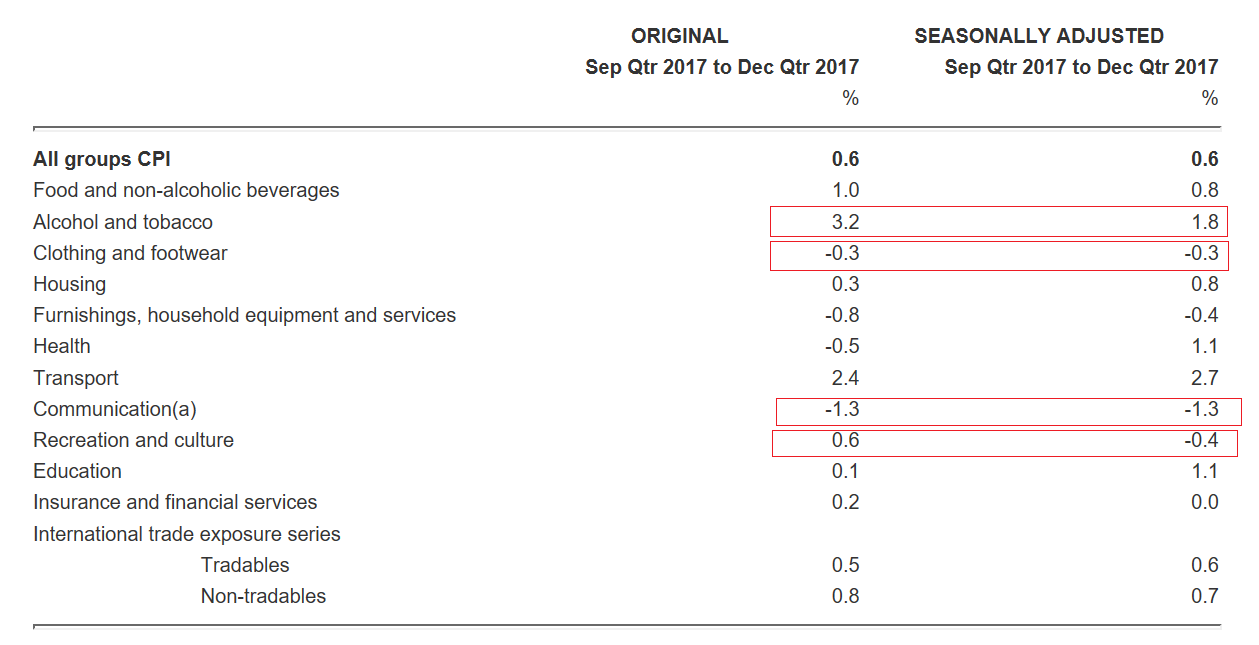Australian Dollar Put Under Pressure by the Pound after Subdued Inflation Report

Slower-than-forecast inflation data is seen hampering the Australian Dollar.
The Australian Dollar fell after the release of weak Australian inflation data for the fourth quarter early on Wednesday, January 31.
The data from the Australian Bureau of Statistics showed Q4 inflation missing expectations and rising by only 0.6% compared to the third quarter and 1.9% compared to Q4 of the previous year.
Expectations had been for a 0.7% quarterly rise and a 2.0% yearly increase.
The disappointing outcome saw the Pound-to-Australian Dollar exchange rate fall to an intra-day low at 1.7444.
The yearly rate was below the Reserve Bank of Australia's (RBA) 2-3% target zone making it unlikely the RBA will raise interest rates anytime soon, and potentially bringing into doubt their guidance that the next move would probably be to raise rates rather than cut them.
Interest rates have a profound impact on currencies as they tend to attract more inflows of foreign capital when they rise and vice versa when they fall.
The Australian Dollar fell from being able to purchase 0.8100 US Dollars before the release to 0.8055 after the data - a drop of almost half a cent.
Get up to 5% more foreign exchange by using a specialist provider to get closer to the real market rate and avoid the gaping spreads charged by your bank when providing currency. Learn more here.
The Pound to Dollar meanwhile rose from a Pound being able to buy 1.7480 to a post-release 1.7580, a whole cent difference.
The individual constituent groups of goods which make up CPI provide a more detailed breakdown of where inflation pressures are emerging and why it remains so muted overall.
The two largest contributors to inflation in Q4 were Tobacco and Oil.
The former rose 8.5% and the latter 10.4% but neither was driven by economic growth.
The rise in tobacco reflected the "continued impact of the increase in the federal excise tax at the beginning of the September quarter," according to senior economists Janu Chan and Jo Horton at St George Economics, as opposed to a growth in real demand for cigarettes.
The rise in fuel inflation was driven by a rise in global oil prices rather than demand.
Fruit also rose 9.3% but this was more as a result of poor weather impacting on the harvest than demand.
Domestic Travel also rose 6.3% but this was due to the October holiday:
"The main contributor to the rise in the recreation and culture group this quarter is domestic holiday travel and accommodation (+6.3%). The rise in domestic holiday travel and accommodation is due to the October school holidays and the lead up to the peak summer holiday period," says the Australian Bureau of Statistics (ABS).
Some key constituents actually showed price deflation in Q4 as a result of increased competition, mainly.
The main deflationary category was communication.
"The main contributor to the fall in the communication group this quarter is telecommunication equipment and services (-1.4%).
The fall was partially offset by a rise in postal services (+1.7%). Over the last twelve months, the communication group fell 3.4%," says the ABS.
Footwear and Clothing also continued discounting.
"The main contributor to the fall in the clothing and footwear group this quarter are garments for women (-1.5%) and footwear for women (-1.8%) due to ongoing competition and continued discounting activity in the retail industry," report the ABS.
Although the muted inflation growth has lessened the chances of an RBA interest rate hike, some analysts still see the possibility of a tightening labour market in Australia where unemployment is now at historic lows, as potentially providing a boost to inflation and providing the trigger for an RBA hike instead.
"Despite the weak outlook for inflation, the improving labour market could become greater focus and a bigger potential trigger for an RBA rate hike. There is a strong prospect that the unemployment rate will edge lower and the labour market will tighten over the course of this year," says a note from Australian lender St George Bank.
Yet, even so, wages remain subdued and it is from rising wages that inflation tends to ultimately come.
"That said, spare capacity in the labour market remains, and points to wages and inflation remaining subdued for some time. This would suggest little need to be hiking rates anytime soon." They conclude.
Get up to 5% more foreign exchange by using a specialist provider to get closer to the real market rate and avoid the gaping spreads charged by your bank when providing currency. Learn more here.







